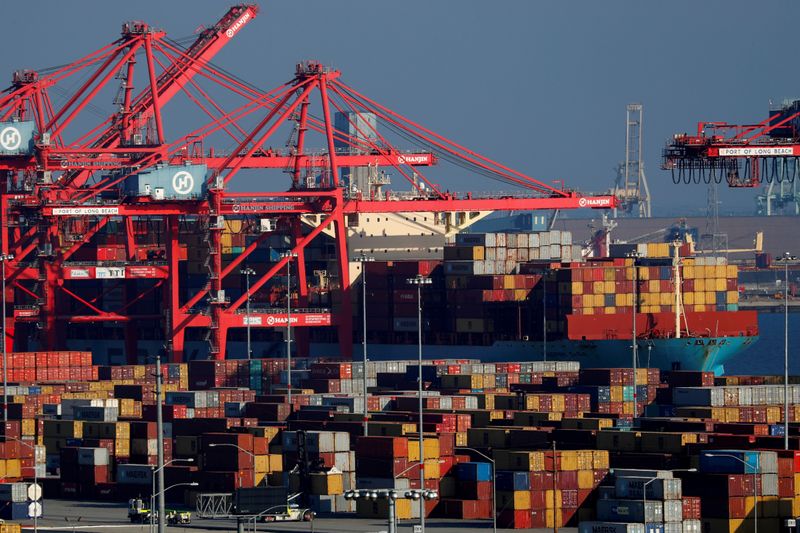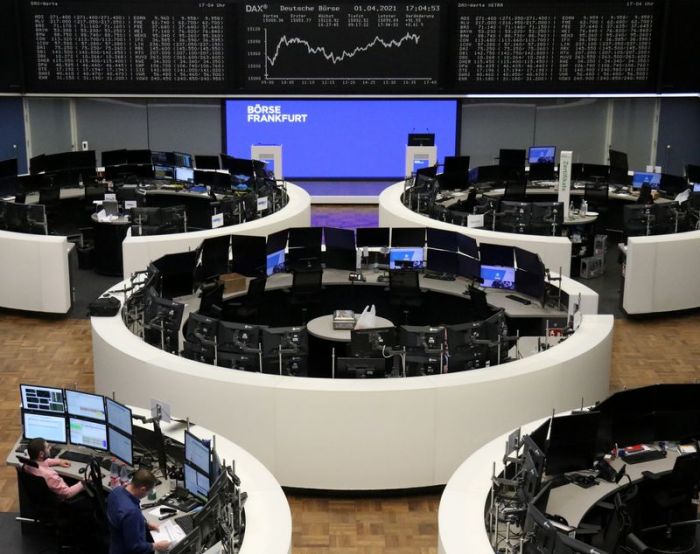WASHINGTON (Reuters) -The U.S. trade deficit surged to a record high in February as the nation’s economic activity rebounded more quickly than that of its global rivals and could remain elevated this year, with massive fiscal stimulus expected to spur the fastest growth in nearly four decades.
The economy is roaring as increased COVID-19 vaccinations and the White House’s $1.9 trillion pandemic rescue package boost domestic demand, a chunk of which is being satiated with imports. President Joe Biden last week proposed a $2 trillion infrastructure plan, expected to pull in even more imports and fire up economic growth.
“The deficit could remain wide this year and next because of the fiscal stimulus and potential infrastructure package that could pass in the second half of this year,” said Ryan Sweet, a senior economist at Moody’s Analytics in West Chester, Pennsylvania. “As the economy continues to strengthen, this will keep the deficit wide.”
The trade deficit jumped 4.8% to a record $71.1 billion in February, the Commerce Department said on Wednesday. Economists polled by Reuters had forecast a $70.5 billion deficit. The goods trade gap was also the highest on record.
Exports dropped 2.6% to $187.3 billion. Exports of goods tumbled 3.5% to $131.1 billion, likely hurt by unseasonably cold weather across large parts of the country. The decline was led by shipments of capital goods, which decreased $2.5 billion.
Consumer goods exports fell as did those of motor vehicles, parts and engines. There were also fewer food exports. The pandemic remained a drag on services exports, especially travel.
Imports slipped 0.7% to $258.3 billion. Goods imports fell 0.9% to $219.1 billion. The drop likely reflected supply-chain constraints, rather than weak domestic demand. Indeed, imports of capital goods hit a record high, boosted by civilian aircraft, medical equipment and electric equipment among others.
Imports of industrial supplies and materials were the highest since October 2018, thanks to $1 billion worth of crude oil imports. That resulted in the United States recording its first petroleum deficit since December 2019.
But imports of motor vehicles, parts and engines decreased as did those of consumer goods. The reduction in trade flows in February was partly due to harsh weather, logistic and transportation problems at ports.
“Congestion at the ports of Los Angeles and Long Beach, which together account for a third of U.S. container imports, caused container ships to anchor offshore while waiting for available port space,” said Jay Bryson, chief economist at Wells Fargo Securities in Charlotte, North Carolina.
“Even when ships are docked and unloaded, port executives report higher than normal container dwell time, or the time it takes importers to pick up their cargo from port.”
Following the recent six-day blockage of the Suez Canal, economists expect trade flows remained depressed in March.
Stocks on Wall Street were trading higher. The dollar slipped against a basket of currencies. U.S. Treasury prices were mostly higher.
DRAG ON GROWTH
When adjusted for inflation, the goods trade deficit shot up to a record $99.1 billion in February from $96.1 billion in January. The so-called real trade deficit is running well above the average for the October-December period.
Economists at JPMorgan estimate trade could subtract a full percentage point from GDP growth in the first quarter, which would be the third straight quarterly drag.
But that is unlikely to make a dent on first-quarter GDP growth estimates, currently as high as a 10% annualized rate. The economy grew at a 4.3% pace in the fourth quarter.
Economists expect growth this year could top 7%, which would be the fastest since 1984. The economy contracted 3.5% in 2020, the worst performance in 74 years. The International Monetary Fund is forecasting the global economy to expand 6% this year, driven primarily by the U.S. economy, which the fund estimated would grow by 6.4%.
From the labor market to manufacturing and the hard-hit services industries, activity accelerated sharply in March.
But the housing market, one of the pandemic star performers is showing signs of fatigue.
A separate report from the Mortgage Bankers Association (MBA) on Wednesday showed applications for loans to buy a home fell 4.6% last week, dropping for a second straight week.
According to the MBA, the 30-year mortgage fixed rate has risen to 3.36%, a 10-month high. That, combined with higher house prices due to an acute shortage of properties, is making home-ownership more expensive for some first-time buyers.
“With inventory at record lows and affordability increasingly stretched thanks to rapid house price gains, we expect home purchase demand will trend down this year,” said Matthew Pointon, senior property economist at Capital Economics in New York.
(Reporting by Lucia MutikaniEditing by David Goodman and Paul Simao)
























